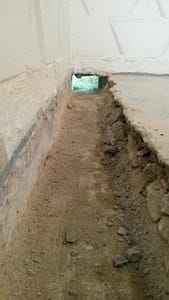What Does Best Basement Waterproofing Mean?
What Does Best Basement Waterproofing Mean?
Blog Article
Best Basement Waterproofing - Truths
Table of ContentsThe 15-Second Trick For Best Basement WaterproofingHow Best Basement Waterproofing can Save You Time, Stress, and Money.Some Known Incorrect Statements About Best Basement Waterproofing Best Basement Waterproofing for DummiesThe 5-Minute Rule for Best Basement Waterproofing
What causes water damage problems in your basement? Right here are a couple of points to look for: when the structure of your home is compromised, water is extremely good at creeping in between small cracks and crevices and triggering damages. Pipelines that line the within of your walls are just one instance of where water damage can take place.The dirt and ground of your home is very vital. If there is way too much water surrounding your home, nonetheless, it can press the dirt right into your home and trigger the seals of your cellar to come to be jeopardized. Best Basement Waterproofing. when you see excess water in areas where it must not be, that is an excellent indication that you have an issue
You apply the finish with a hefty brush made with bristles swirled throughout application for an appealing, ended up appearance. Concrete waterproof coverings can not be used to previously painted surface areas Silicate-based concrete sealers, also understood as densifiers, are also appropriate just for walls that have not been repainted or secured.
Because these are permeating sealants, they can not flake off or peel off, and you can have paint used over them. The American Eagle team may find a lot more challenging causes for your wetness concerns; there are added solutions readily available. Plastic sheets and panels may be incorporated with indoor basement water drainage systems. They do not stop water from surviving the wall, however they do stop it from wrecking things in the cellar.
Indicators on Best Basement Waterproofing You Need To Know
A sump pump is needed to move water out of your cellar. In order to correctly advise a solution for your damp basement, call American Eagle for a no-obligation check out. Our service technicians will be able to explain which services are alternatives for your home. Why should you waterproof your basement? Right here are a few things the experts can install to aid the waterproofing procedure: this is made for the wall surfaces of your cellar (Best Basement Waterproofing).

Basement waterproofing is a wonderful means to obtain ahead of potential water damages that may come your means.
Best Basement Waterproofing Fundamentals Explained
When it involves protecting your home, among one of the most crucial steps you can take is basement waterproofing. A completely dry basement not just makes certain a risk-free and healthy and balanced atmosphere for you and your family, however it likewise aids to avoid costly water damages and mold growth. In this blog message, we will review the value of basement waterproofing, the advantages it provides, and how you can tackle securing your room.
By investing in cellar waterproofing now, you his comment is here can help to ensure that your home preserves its value and attractiveness over time. One more benefit of basement waterproofing is that it can assist to lower your energy bills. A wet basement can add to greater degrees of humidity in your home, which can make your heating and cooling system job tougher to preserve a comfy temperature level.
When it involves cellar waterproofing, there are numerous techniques that can be made use of to keep water out of your area. These consist of interior sealants, outside waterproofing membrane layers, and water drainage systems. The best approach for your basement will certainly depend upon variables such as the level of water breach, the condition of your structure, and your spending plan.
In final thought, basement waterproofing is a crucial action in shielding your home from water damage, discover here mold and mildew development, and other issues. By spending in cellar waterproofing, you can make certain that your space stays dry, secure, and healthy for you and your household. Not just does basement waterproofing give tranquility of mind and security for your home, but it can also increase its value and conserve you money on power prices over time.
Some Known Questions About Best Basement Waterproofing.
Interior sealants are a kind of basement waterproofing technique that includes using a sealant to the inside of the basement wall surfaces and floorings. Water can permeate into a cellar via fractures, gaps, or porous concrete, particularly in areas where there is high groundwater or bad drain. This can bring about water damage and mildew growth, along with damages to the structure and structural integrity of the structure.
The sealant develops a barrier that prevents water from permeating through the concrete. This technique is only reliable for minor water damages and does not resolve the underlying reasons of the dampness. The major resource of the need for outside cellar waterproofing is water infiltration from the outside of the internet structure walls.
It is an efficient service for stopping water damage and protecting the structural stability of the building. It can be pricey and turbulent to install, as it requires excavation around the structure and may entail landscape design and other repair work once the waterproofing is full. This technique is the most trustworthy and resilient solution for preventing water seepage in the cellar.
5 Simple Techniques For Best Basement Waterproofing
Report this page